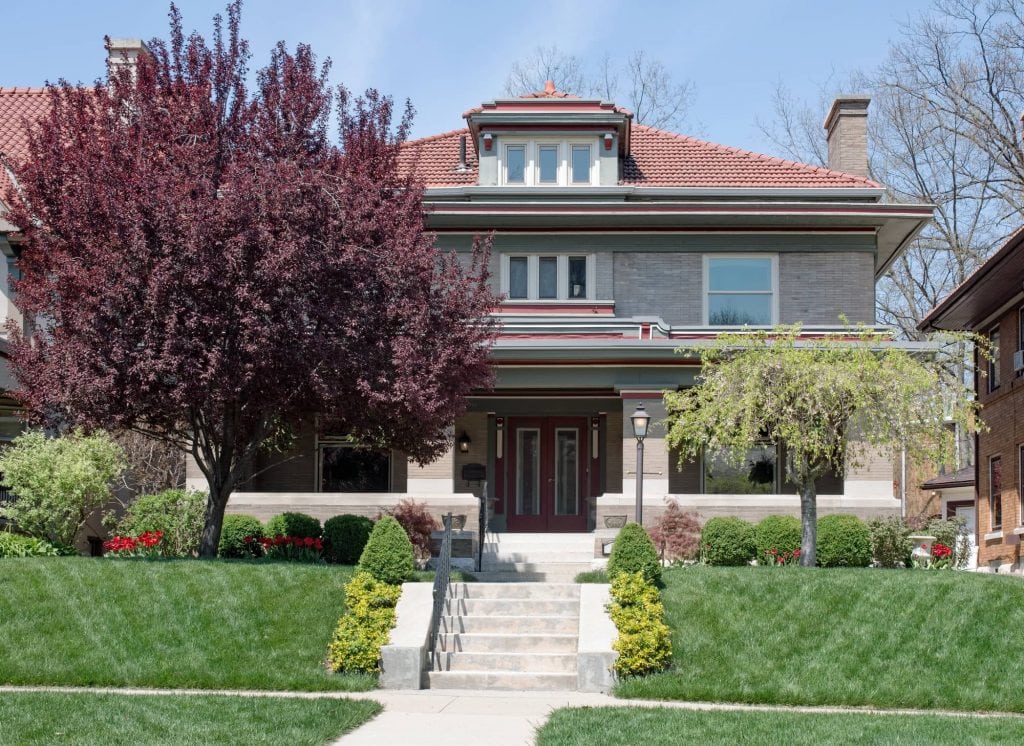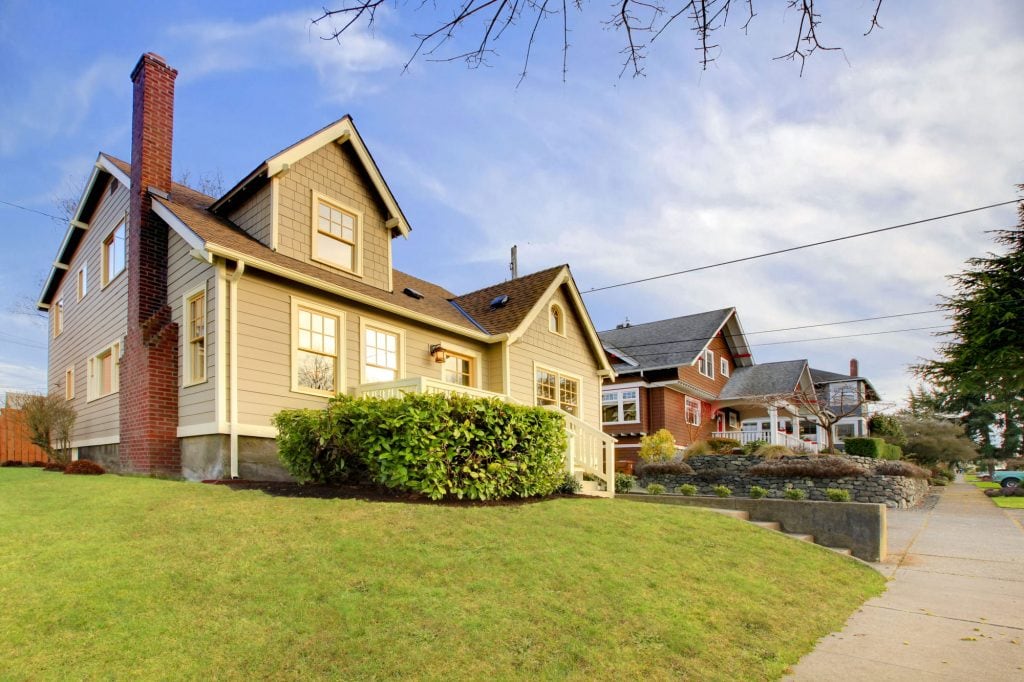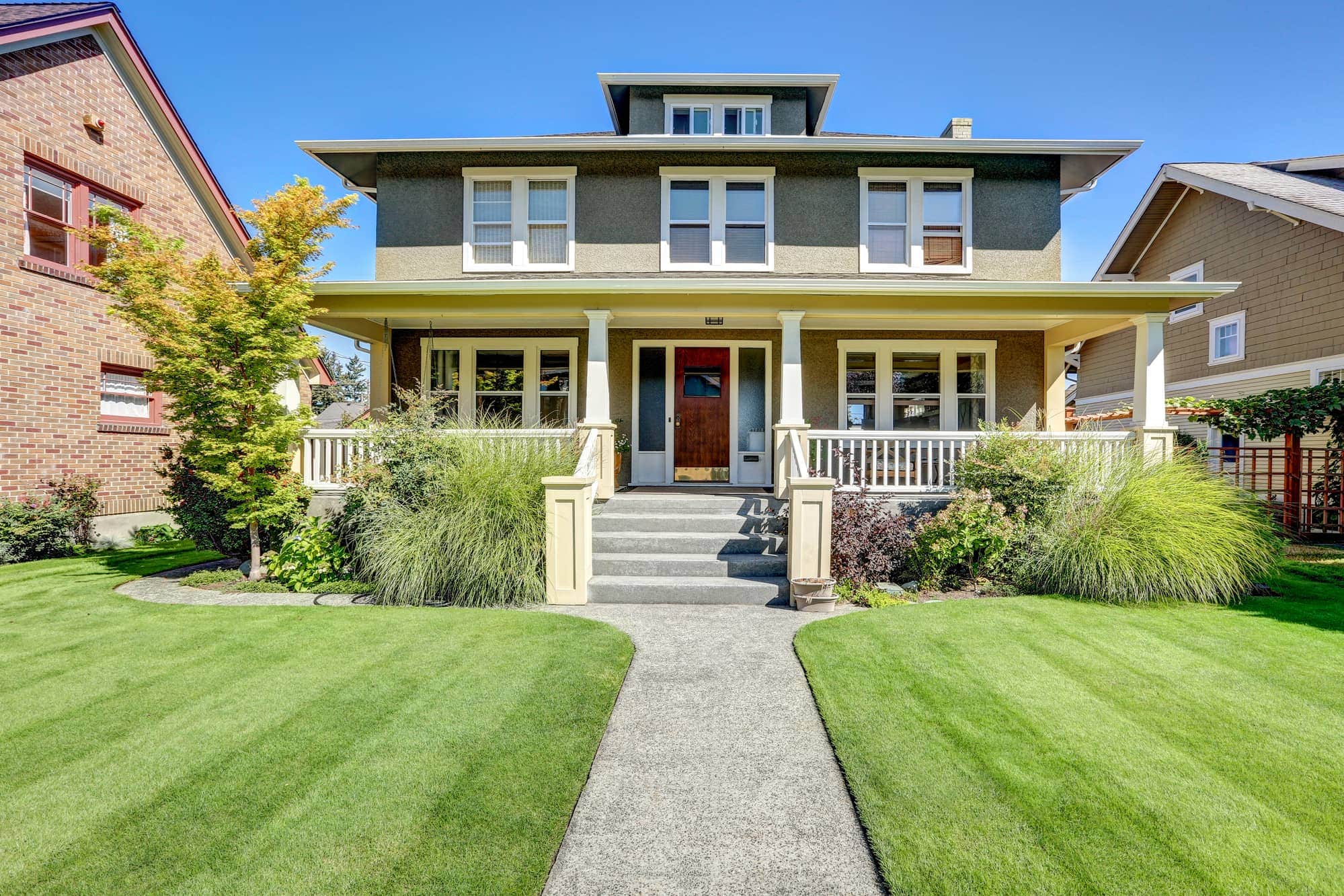In the diverse realm of American architecture, the Craftsman-style house has emerged as a unique and iconic design, echoing the trends of the 20th Century while retaining its timeless appeal. They reflect timeless aesthetics and values that always stay in style.
The charm of the Craftsman house, deeply rooted in the Arts and Crafts movement, celebrates handcrafted details and emphasizes harmony with nature.
For those looking to explore the historical and aesthetic significance or even consider purchasing such a gem, explore the vast nationwide listings with eXp Realty using their advanced home search features.
What Is a Craftsman-Style House?
Delving into the world of architectural styles, the Craftsman style house stands out not just as an architectural marvel but also as a reflection of a cultural shift.
This style rose to prominence, particularly in Southern California, in the early 20th Century, emerging as a counter to the mass-produced goods of the Industrial Revolution.
Craftsman architecture utilizes handcrafted elements and the beauty of natural materials. The style lends attention to details, emphasizing craftsmanship, earth tones, and its seamless integration with nature as signature design characterizations.
History and Origins
Tracing back to the 19th Century, the Craftsman style traces back to its roots in the British Arts and Crafts movement. This movement was not merely an architectural or design shift but a social movement that vouched for the return to handcrafted goods, countering the rising tide of mass-produced items during the Industrial Revolution.
Introduction to the style to the American audience launched via the American Arts And Crafts Exhibition. The American population enthusiastically embraced it.
The Gamble House in Pasadena, crafted by the renowned architect brothers Charles Greene and Henry Greene, is a prime example of Craftsman architecture. Their Pasadena-based firm, Greene & Greene, introduced unique design plans and architectural details that became synonymous with the Craftsman style.
Key Features of Craftsman Houses
At the heart of Craftsman houses are some defining features:
- Natural Materials: Earthy tones and materials like wood siding, stone accents, and clapboard siding reign supreme.
- Low-Pitched Roofs: Craftsman homes often feature low-pitched gable or hipped roofs complemented by wide eaves.
- Tapered Columns: One of the most distinctive features, these often support wide porches, adding to the house’s horizontal lines.
- Built-In Elements: From built-in bookshelves and cabinets to window seats, these houses showcase handcrafted details at every turn.
- Unique Windows: Double-hung windows with multi-pane glasses on the top and a single pane on the bottom are common, offering a blend of privacy and natural light.
Craftsman vs. Other Architectural Styles
While the Craftsman style is distinctive, it often gets compared to other types, notably Prairie-style homes and Victorian homes.
Prairie-style homes, deeply influenced by Japanese architecture, are marked by their horizontal lines and flat or hipped roofs. Victorian-style homes, popular in the 19th century, are more ornate, featuring decorative brackets, gabled roofs, and vibrant color palettes.
Modern-Day Craftsman Houses
In the 21st Century, the Craftsman style remains popular, evolving to accommodate modern amenities while retaining its historic charm. Current Craftsman house plans incorporate the architectural design’s key features, ensuring the legacy of this landmark style.

Whether it’s a Craftsman bungalow in San Diego or a two-story home in Northern California, the essence remains consistent.
eXp Realty offers current real estate listings searchable by zip code, county, or city.
Why Invest in a Craftsman-style house?
Owning a Craftsman style house is not just about possessing a property; it’s about embracing a slice of American architectural history.
Craftsman’s strong emphasis on harmony, nature, and craftsmanship offers a warm and inviting home with popularity ensuring a good investment. Its unique design plans and house designs make it a sought-after property type among American families.
Distinctive Design Elements of Craftsman Style Houses
At a glance, Craftsman style houses invite you in with their signature aesthetic, harking back to an era where handcrafted detailing was paramount. With every brick laid and wooden panel set, these homes are a testament to the meticulous care and attention to design that went into their creation. Here are some of the most iconic design elements that define Craftsman style houses:
- Emphasis on Craftsmanship and Natural Materials: Unlike the mass-produced offerings that flooded the market during the Industrial Revolution, Craftsman Homes showcased the beauty of handwork. They predominantly used natural materials such as wood, stone, and brick.
- Strong Horizontal Lines and Low-Pitched Roofs: One of the most distinguishing features is their horizontal emphasis, often represented by wide porches, low-pitched gable or hip roofs, and broad frontages.
- Handcrafted Details and Decorative Elements: From decorative brackets under the roof eaves to intricate tilework and stained glass, each Craftsman home brims with unique details. Features like gable brackets, wooden siding, and stucco accents showcase skilled artisan handiwork.
- Integration of Nature and Outdoor Spaces: Craftsman homes often blur the lines between the indoors and outdoors. Wide porches invite homeowners to enjoy nature and provide a seamless transition between the inside and outside spaces.
- Exposed Structural Elements: Craftsman homes proudly show off their ‘bones’. Exposed rafters, beams, and decorative brackets are not just structural necessities but become design highlights, celebrating the home’s construction.
- Open Floor Plans and Flowing Spaces: Unlike the compartmentalized Victorian-style homes, Craftsman houses embraced open floor plans. This design ensures a seamless flow between living, dining, and kitchen areas, promoting communal living and spaciousness.
- Built-in Cabinetry and Furniture: Efficiency meets design in these homes. Built-in bookshelves, benches, cabinetry, and dining areas are typical, maximizing space while adding character.
- Natural Light and Ample Windows: Craftsman homes value the importance of natural light. Features like multi-pane and large picture windows are staples, illuminating interiors and offering picturesque views.
- Use of Earthy Color Palettes and Rich Textures: Drawing inspiration from nature, these homes showcase earthy tones—warm browns, greens, and muted reds. The textures of natural wood, stone accents, and handcrafted tiles often complement these.
- Other Features: Craftsman style houses often feature wraparound porches, wooden or tile flooring, and a strong emphasis on horizontal siding, especially clapboard or shingle. Integrating Arts & Crafts furniture designs, Japanese architectural influences, and even mission revival elements influence various iterations of Craftsman homes nationwide.
Craftsman style houses are not just homes; they’re art pieces, echoing the ethos of a bygone era while remaining evergreen in their appeal. They are a testament to a time of passion, care, and reverence for nature and craftsmanship.
Popularity and Resurgence of Craftsman Style
Architectural trends have seen the Craftsman style’s popularity rise, wane, and rise again, a phoenix reborn from its sawdust. Today, Craftsman houses hold a cherished spot in the hearts of homeowners and architects alike. Let’s trace the journey of this iconic style and understand its enduring charm.

Decline and Resurgence
Born as a reaction against the mass-produced, impersonal design tendencies of the 19th century’s Industrial Revolution, the Craftsman movement thrived in the early 20th century. However, as the world moved towards the mid-century, its charm waned, replaced by newer architectural styles and mass-produced homes.
But as the 21st century dawned, a renewed appreciation for handiwork, individuality, and sustainable materials led to the Craftsman’s resurgence. The timeless nature of its design, combined with a societal shift towards authenticity, played a pivotal role in this revival.
Modern Homeowners’ Appeal
Today’s homeowners, especially those put off by cookie-cutter houses, find solace in the Craftsman’s unique character. With intricate details and solid craftsmanship, each home tells a story, creating a personal connection between the house and its inhabitants.
Timeless Aesthetic and Architectural Integrity
The Craftsman’s emphasis on natural materials, attention to detail, and harmony with nature offers an aesthetic that always stays in style. This architectural integrity ensures that the house remains a visual delight, decade after decade.
Appreciation for Craftsmanship and Quality
As we increasingly live in a world of mass-produced goods, there’s a growing nostalgia and appreciation for items created with care, skill, and passion. Craftsman homes, emphasizing handcrafted details, tap into this sentiment.
Connection to Nature and Outdoor Living
Modern homeowners are rediscovering the joys of integrating living spaces with the outdoors. The Craftsman’s wide porches, large windows, and nature-inspired color palettes resonate deeply with this desire.
Modern Adaptations and Reinterpretations
While staying true to the Craftsman ethos, many architects and designers give these houses a modern twist. Newer Craftsman homes might incorporate open-concept floor plans, loft spaces, or even home automation, blending tradition with modernity.
Sustainable and Eco-friendly Elements
With sustainability becoming a significant concern, the Craftsman’s use of natural, local materials and energy-efficient designs makes it an excellent choice for the environmentally-conscious homeowner.
Blending Craftsman with Contemporary Trends
It’s not uncommon to see Craftsman homes that incorporate elements from contemporary design, be it furniture, lighting fixtures, or even space utilization. This amalgamation ensures that while the house retains its Craftsman soul, it feels in the right place in today’s world.
A knowledgeable eXp Realty agent can walk you through your city’s current Craftsman style home listings.
Key Takeaways
Craftsman style houses, with their unique architectural signatures and timeless beauty, have weathered the ups and downs of design trends over the years.
If you’ve found yourself captivated by the undeniable charm of Craftsman architecture and are considering making one such masterpiece your home, remember that the journey becomes seamless with expert guidance.
A licensed real estate agent is invaluable in any home search or real estate transaction. From property tax knowledge to tips on value-added improvements, real estate agents are experts on their listing areas and trends.
Whether you are considering a move or want to explore available properties, visit the eXp Realty website, or contact a dedicated eXp agent who can help you find your dream Craftsman home in your desired area.
FAQs: Craftsman-Style House
Craftsman style houses, with their distinctive characteristics and rich history, naturally spark numerous questions. Here’s a comprehensive guide to frequently asked questions to shed more light on this iconic architectural style.
What makes a house a Craftsman style?
Craftsman houses are known for their handcrafted details, earthy color palettes, strong horizontal lines, low-pitched roofs, and an emphasis on natural materials. They often feature exposed rafters, built-in furniture, and ample windows to invite in natural light.
What are the four types of Craftsman houses?
The four main types of Craftsman houses are:
- Bungalow: A single-story home with a spacious front porch.
- Prairie: Characterized by flat lines, horizontal details, and square porches.
- Mission Revival: Influenced by Spanish missions, these homes often have stucco exteriors and red tile roofs.
- Four Square: Typically two stories tall, these houses are known for their square shape and dormer windows.
What is another name for a Craftsman style home?
Another name for a Craftsman style home is an “Arts and Crafts” home. This name is rooted in the Arts and Crafts Movement, which emphasized handcrafted artistry over mass production.
What is a modern Craftsman style house?
A modern Craftsman style house retains the original characteristics like handcrafted details and natural materials but incorporates contemporary design elements. These include open floor plans, state-of-the-art amenities, and sleeker lines, blending the traditional with the modern.
What period is the Craftsman style?
Craftsman style originated during the late 19th century and gained peak popularity in the early 20th century, particularly between the 1900s and the 1930s.
What is Craftsman vs. bungalow style?
While both styles share similarities, the primary difference is size and layout. Craftsman homes can be large and multiple stories tall. In contrast, bungalows are typically one or one-and-a-half stories characterized by their compact design.
What is a Craftsman style kitchen?
A Craftsman style kitchen emphasizes natural materials like wood for cabinetry and counters. It often features built-in cabinetry, earthy color palettes, and handcrafted tiles, ensuring functionality without compromising aesthetics.
What is a Craftsman farmhouse?
A Craftsman farmhouse merges the handcrafted details of Craftsman homes with the rustic charm of farmhouses. This style combines the best of both worlds, offering modern amenities with a touch of countryside allure.
What is a Craftsman style porch?
A Craftsman style porch often features tapered or square columns supporting the roof, wide porches, and multi-pane windows. It serves as an extension of the living space, emphasizing the harmony between indoor and outdoor areas.
What are Craftsman style doors?
Craftsman style doors are typically made of wood and feature straight lines and rectangular patterns and often include a window on the upper third part of the door, with multiple panes.
What states have Craftsman style homes?
You can find Craftsman style homes across the United States, but they are particularly prevalent in Southern California cities like San Diego and Pasadena. Other states with notable Craftsman homes include Washington, Oregon, and parts of the Midwest.





